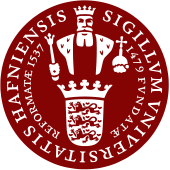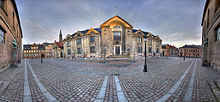Københavns Universitet | |
 | |
| Latin: Universitas Hauniensis[1][2][3] or Hafniensis[4] | |
| Motto | Latin: Coelestem adspicit lucem |
|---|---|
Motto in English | It (the eagle) beholds the celestial light |
| Type | Public research university[5] |
| Established | 1 June 1479 |
Academic affiliation | IARU LERU EUA Europaeum Universities Denmark[6] |
| Budget | DKK 8.908 bn ($1.338 bn) (2018)[7] |
| Rector | Henrik C. Wegener[8] |
Academic staff | 5,286 (2019)[9] |
Administrative staff | 4,119 (2017)[9] |
| Students | 37,493 (2019)[10] |
| Undergraduates | 21,394 (2019)[10] |
| Postgraduates | 16,079 (2019)[10] |
| 3,106 (2016)[11] | |
| Location | , 55°40′47″N 12°34′21″E / 55.67972°N 12.57250°E |
| Campus | Urban 94.2 ha (total) |
| Student newspaper | Uniavisen |
| Colors | Maroon and gray[12] |
| Website | www.ku.dk |
The University of Copenhagen (Danish: Københavns Universitet, abbr. KU) is a public research university in Copenhagen, Denmark. Founded in 1479, the University of Copenhagen is the second-oldest university in Scandinavia after Uppsala University.
The University of Copenhagen consists of six different faculties, with teaching taking place in its four distinct campuses, all situated in Copenhagen.[13][14] The university operates 36 different departments and 122 separate research centres in Copenhagen, as well as a number of museums and botanical gardens in and outside the Danish capital.[15] The University of Copenhagen also owns and operates multiple research stations around Denmark, with two additional ones located in Greenland.[16][17] Additionally, The Faculty of Health and Medical Sciences and the public hospitals of the Capital and Zealand Region of Denmark constitute the conglomerate Copenhagen University Hospital.[18]
As of October 2022, 10 Nobel laureates[19] and 1 Turing Award laureate have been affiliated with the University of Copenhagen as students, alumni or faculty.[20] Alumni include one president of the United Nations General Assembly and at least 24 prime ministers of Denmark.
- ^ Record of the Jubilee Celebrations of the University of Sydney. Sydney, New South Wales: William Brooks and Co. 1903. ISBN 9781112213304.
- ^ Records of The Tercentenary Festival of Dublin University. Dublin, Ireland: Hodges, Figgis & Co. 1894. ISBN 9781355361602.
- ^ Anderson, Peter John (1907). Record of the Celebration of the Quatercentenary of the University of Aberdeen: From 25th to 28th September, 1906. Aberdeen, United Kingdom: Aberdeen University Press (University of Aberdeen). ASIN B001PK7B5G. ISBN 9781363625079.
- ^ Record of the Jubilee Celebrations of the University of Sydney. Sydney, New South Wales: William Brooks and Co. 1903. ISBN 9781112213304.
- ^ "About the universities". Ministry of Higher Education and Science. Archived from the original on 13 January 2020. Retrieved 13 January 2020.
- ^ "Universities Denmark". Universities Denmark. Archived from the original on 9 August 2018. Retrieved 26 July 2020.
- ^ "Økonomi". University of Copenhagen. 23 August 2016. Archived from the original on 20 April 2019. Retrieved 18 November 2019.
- ^ "Rector". University of Copenhagen. 28 February 2017. Archived from the original on 25 July 2020. Retrieved 25 July 2020.
- ^ a b "Employees". University of Copenhagen. 23 August 2016. Archived from the original on 15 August 2019. Retrieved 24 July 2020.
- ^ a b c "Students". University of Copenhagen. 23 August 2016. Archived from the original on 25 February 2019. Retrieved 25 July 2020.
- ^ "Forskning og formidling" [Research and circulation] (in Danish). University of Copenhagen. Archived from the original on 26 July 2017. Retrieved 16 January 2015.
- ^ "University of Copenhagen Design Guide". University of Copenhagen. 4 December 2008. Archived from the original on 6 August 2020. Retrieved 24 August 2020.
- ^ "Faculties of the University of Copenhagen". University of Copenhagen. 16 September 2008. Archived from the original on 3 August 2020. Retrieved 25 July 2020.
- ^ "Departments at the University of Copenhagen". University of Copenhagen. 16 September 2008. Archived from the original on 3 August 2020. Retrieved 25 July 2020.
- ^ "Museums". about.ku.dk. 16 September 2008. Archived from the original on 3 August 2020. Retrieved 24 July 2020.
- ^ "Areas of research". research.ku.dk. 28 May 2019. Archived from the original on 12 August 2020. Retrieved 24 July 2020.
- ^ https://www.science.ku.dk/fakultetet/organisation/feltstationer/ Archived 12 August 2020 at the Wayback Machine (in Danish). Retrieved 24 July 2020.
- ^ Larsen, Jørgen Falck; Engelbrecht, Nils: Københavns Universitetshospital in 'Den Store Danske' at https://denstoredanske.lex.dk/K%C3%B8benhavns_Universitetshospital Archived 24 July 2020 at the Wayback Machine (in Danish). Retrieved 25 July 2020.
- ^ Kommunikation (5 October 2022). "Nobelpristagere". universitetshistorie.ku.dk (in Danish). Archived from the original on 16 October 2022. Retrieved 6 October 2022.
- ^ "Peter Naur - A.M. Turing Award Winner". Archived from the original on 3 July 2017. Retrieved 27 October 2016.

